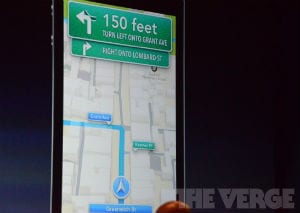 Apple’s annual Worldwide Developer’s Conference (WWDC) isn’t typically a showcase event geared toward HVAC guys, mechanics, or repairmen. But this year’s event, which is going on in San Francisco this week, actually introduced some pretty interesting technology that mobile, field-based workers of all stripes may benefit from.
Apple’s annual Worldwide Developer’s Conference (WWDC) isn’t typically a showcase event geared toward HVAC guys, mechanics, or repairmen. But this year’s event, which is going on in San Francisco this week, actually introduced some pretty interesting technology that mobile, field-based workers of all stripes may benefit from.
Changes to Mapping Service
The biggest — and for field service people, the most relevant — news is that Apple will stop using Google for its mapping services on future iPhones and iPads, instead using its own proprietary technology. The company says its new digital maps will come with more detailed, intelligent overlays and turn-by-turn direction capabilities (something the previous iPhone lacked) and real-time traffic updates. (If you’ve ever used an iPhone for directions, you know how annoying it can be to keep checking the phone to see if you made the right turn.)
With the new operating system in iPhones, field techs on the road can receive updated, turn-by-turn directions and can get automatically rerouted if traffic builds up on the way. “Siri” integration will also allow drivers to do this all hands-free — and there were mentions of a Siri button coming pre-installed on some high-end car steering wheels in the future.
Open-Source Siri
Speaking of Siri, Apple hasn’t yet made an announcement on this yet, but there’s been all kinds of scuttlebutt suggesting the company may soon release an API (application programming interface) that lets developers tap into the voice assistant for their own apps, which would open up a whole world of possibilities for great new voice-commanded apps. Imagine asking Siri to find a bit of data within a report housed on your iPhone, or asking her to close a work order or search for a warranty. While the API, for now at least, is still a ways off, its specter holds huge potential for all sorts of field service people.
FaceTime on 3G
“Imagine a repairman at a remote utility substation who wants to get his boss or co-worker’s help in diagnosing problems with a malfunctioning machine. Or an emergency medical technician treating a bleeding patient who needs immediate advice from a physician before arriving at the ER. Or a property inspector at the site of a foreclosed home who wants help evaluating damages to the property from someone back at corporate.
“In all of these scenarios, live, interactive video could be extremely helpful – certainly far more so than static images or even video clips embedded into reports after the fact. The big question is how well Facetime will perform in remote areas when 4G LTE is unavailable and 3G is spotty. But that may be an edge scenario. I expect field service app vendors like my employer SAP to start leveraging Facetime in their offerings. This could accelerate the move away from ruggedized devices to consumer ones fitted with an Otterbox or similar tough case.”
The new platform isn’t going to be released until the Fall, but for now, there are some enticing developments field service folks can get excited about.
More: City Governments Leading Charge Toward App-Based Service Requests.
Click here to download a free whitepaper, “Five Steps to Make Field Service Profitable.”

Its not quite correct to say iOS6 includes turn by turn directions – as this is dependent on the next generation of hardware as well. To clarify – putting iOS6 one your iPhone 4s isn’t going to give you turn by turn!
Thanks for the clarification Karl.